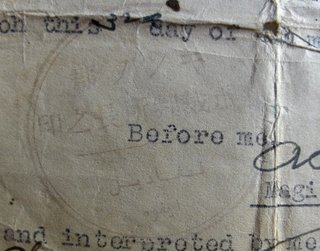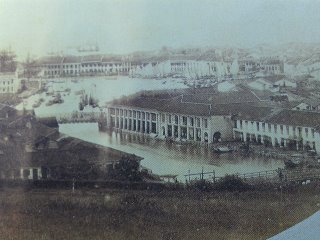 This declaration letter was neatly type-written in English and is nearly 65 years ago. It was a declaration of ownership of a bicycle. To make it legal and binding, it also bore the officially stamped of the Stamp Office of Perak. Had it not been for the date and the other stamps on it, it would have been another court document from the British colonial period. However pouring thro the details, it unravels more than what that meets the eyes. It reveals an anachronism that could only be found in the history of that time.
This declaration letter was neatly type-written in English and is nearly 65 years ago. It was a declaration of ownership of a bicycle. To make it legal and binding, it also bore the officially stamped of the Stamp Office of Perak. Had it not been for the date and the other stamps on it, it would have been another court document from the British colonial period. However pouring thro the details, it unravels more than what that meets the eyes. It reveals an anachronism that could only be found in the history of that time.For the document was issued in the name of the Nippon Government of Perak. It was declared before the Magistrate of Ipoh on the 3th of April 2602. The year was by the Imperial Calendar or Koki. After which the document was probably taken to the Stamp Office of Perak to be stamped, for the Stamp Office chop was dated 4th April and with the year 2602 written over the Gregorian year 19XX.
However there was a higher authority which the Nippon Government of Perak had to accede to and i.e. the - 军政部 / IPO机关 – Gunseibu IPO kikan – Military Department / Ipoh Operation. The stamp from the Military Department - Gunseibu - was ubiquitous on all documents and photographs from that era.
 In addition to the two stamps above, the document also bears the stamp of the Magistrate. The stamp is faintly visible in the photograph, next to the Magistrate signature at the bottom of the page. What is unique and interesting about this stamp is that in addition to the Japanese Kanji / Katakana, it also has two lines of Arabic alphabets on it! The Arabic alphabets is Jawi Malay for ‘Pegadil, Ipoh’ which means ‘Judge, Ipoh’ written in the Malay language.
In addition to the two stamps above, the document also bears the stamp of the Magistrate. The stamp is faintly visible in the photograph, next to the Magistrate signature at the bottom of the page. What is unique and interesting about this stamp is that in addition to the Japanese Kanji / Katakana, it also has two lines of Arabic alphabets on it! The Arabic alphabets is Jawi Malay for ‘Pegadil, Ipoh’ which means ‘Judge, Ipoh’ written in the Malay language.This document could only be a product of that era. A document issued by the Nippon Government of Perak based on the British Colonial law, stamped with a Magistrate chop in Japanese and Jawi Malay, and wetted thro by the Military Department. One ponders why the Jawi characters in the magistrate stamp and what subtle message was the Japanese military ruler sending to the local populace. Were there here as liberator instead of being the new master?
For the Japanese military, in order to win support for the wartime regime, held out promise of self-government to Sout-East Asians, and in a limited way involed the indigenous elite in the adminstration. It was the start of the new regime, and the use of the Jawi in the stamp could be a way for the new ruler to send this message thro - the building of the Greater East Asia Co-Proseperity Sphere - 大東亜共栄圏 Dai-tō-a Kyōeiken - " an attempt by Japan to create a self-sufficient "bloc of Asian nations led by the Japanese and free of Western powers".
Post-script:
1. The fall of Ipoh – 26th Dec 1941
This Boxing Day will be the 65th anniversary of the fall of Ipoh to the Japanese occupation force. On 25th Dec 1941, the last of the British forces destroyed all they could before leaving the town, and the following day, the 6th Division of the Japanese army marched into town. The force move continued its southward march and Singapore fell on Chinese New Year of 1942, Feb 15, about a month and half later.
 2. The culture of – hanko - personal seal
2. The culture of – hanko - personal sealThe making of a person stamp is possibly kept alive nowadays in Chinatown because of the tourist trade. This tradition of keeping a personal seal, though is now mainly confined to the artistic community who practices Chinese calligraphy/ painting. In Japan, the culture of owning a hanko ( 判子) is still commonly practiced among the general population to this day. One can stamp a check using a hanko which bears one’s name.
3. Jawi Malay
Jawi Malay was commonly used among the Malay community before the introduction of Romanized Malay. It was used way back during Raffles day, for the treat which Raffles signed in 1819 with the Temenggong and the Sultan was also written in Jawi. The Hikayat Abdullah the autobiography of the Raffles Malay tutor was written in Jawi. And the National Museum has the original will of the Munishi, as Abdullah was honored as the learned one, written in Jawi Malay.
4. Detail of the declaration letter:
Nippon Government of Perak
FORM OF STATUTORY DECLARATION
I, Koo Kim Fan, residing in house No. 117 Main Road, Menglembu do solemnly & sincerely declare that I am the owner of a bicycle bearing number xxxxxxx 532288, During the war I evacuated to aplace of safety and in consequence I have mislaid the purchase receipt. I have not pledged the said receipt for the loan of money. AND I make this solemn declaration conscientiously believing the same to be true & by virtue of the provisions of the Statutory Declaration Enact 1899.
Subscribed & solemnly declared
By the abovenamed Koo Kim Fan
at Ipon this 3rd day of **il month
2602
Signature of declarant
Before me
Magistrate Ipoh
Sworn and interpreted by me,
Chinese interpreter Magistrate’s Court Ipoh
There are three stamps on the letter:
Stamp 1 – on top left corner
Stamp Office
-4April 19 2602
Ipoh
Stamp 2 - on top right corner
军政部 (Gunsei bu – Military Department)
2602 (year 2602)
IPO机关 (IPO Kikan – Ipoh Operation)
4-4 (date : 4th April)
PERA州支部 (PERA Shyu shibu – Perak State – sub branch)
Stamp 3 – bottom mid-left
KINTA郡 (Kinta Gun – Kinta District)
IPO裁判所长之印 (IPO Saibanshyochyo no in – The seal of the Head of Ipoh Magistrate court)
- jawi character – (Pengadil)
-jawi character – (Ipoh)
Note:
A) The Chinese characters are in Standard Chinese (PRC) and not in Japanese Kanji, due to computer/software limitation.
B) this was the same bicycle in the previous article in which the bicycle tax was paid.
Ref source:
http://www.diggerhistory.info/
/--


 The photograph in the middle was taken by Sachtler & Co in 1863, and twenty years on with the wet collodion positive and collodion negative process photography improved by leaps and bound. The two bridges which were the predecessors of the Elgin Bridge and Coleman Bridge are clearly visible in the picture. In 1862, an iron bridge was imported from Calcutta to replace the wooden footbridge called the Thompson Bridge, and was renamed Elgin Bridge, after the Lord of the same name who was Governor-General of India, 1862-1863. Coleman Bridge spanning New Bridge Road is seen in the right lower corner of the photograph. The two rows of building in the middle is where the Riverwalk Apartment is now. These two storey shop houses have very prominent covered five footways in the shop front, and five foot ways was a building requirement laid out in the Jackson Town Plan.
The photograph in the middle was taken by Sachtler & Co in 1863, and twenty years on with the wet collodion positive and collodion negative process photography improved by leaps and bound. The two bridges which were the predecessors of the Elgin Bridge and Coleman Bridge are clearly visible in the picture. In 1862, an iron bridge was imported from Calcutta to replace the wooden footbridge called the Thompson Bridge, and was renamed Elgin Bridge, after the Lord of the same name who was Governor-General of India, 1862-1863. Coleman Bridge spanning New Bridge Road is seen in the right lower corner of the photograph. The two rows of building in the middle is where the Riverwalk Apartment is now. These two storey shop houses have very prominent covered five footways in the shop front, and five foot ways was a building requirement laid out in the Jackson Town Plan.



